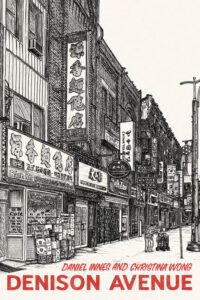June 12, 2023
Denison Avenue, by Christina Wong and Daniel Innes
The nature of cities, of course, is that cities change (I wrote about this in my 2017 essay about Ann-Marie MacDonald’s ADULT ONSET, a book that maps on to this one in surprising and interesting ways), but anyone who loves that city or calls it home is going to struggle with that, or maybe that’s even just the baked-in nostalgia that comes from being alive. I’m well accustomed to stories and images of “Old Toronto,” the kinds of photos that get shared in Facebook groups with names like “Long-Gone Toronto,” the kinds of images that Kamal Al-Solaylee writes about in his 2014 essay “What You Don’t See When You Look Back,” about the whiteness of these vintage scenes: “The pictures depict a world where only white people roamed the streets or were allowed into the frame. I can’t help but conclude that the friends who post them would have preferred it if Toronto had stayed that way: small town, white, exclusive and free from people who look like me.”
But in their new book, DENISON AVENUE, Christina Wong and Daniel Innes are doing something different, and in more ways than one. First, the book itself, which is double sided, one side telling the story gorgeously in Wong’s prose and poetry fragments, and the other with panels showing Innes’s drawings of Toronto “now and then,” now being about ten years ago—when Honest Eds was sold and the Kromer Radio property on Bathurst was going to be developed into a WalMart—and then during the years before it with a thriving Chinatown and Kensington Market, before these areas had become ripe for development and working class people could live a decent life downtown.

Within Innes’s contemporary drawings, a figure appears pushing a cart along the sidewalk, picking up cans and bottles along the way, a figure I didn’t even notice the first time I flipped through the book, which is the point of the book, about what remains invisible, and who gets to be seen, and heard.
The woman in the drawings is Wong Cho Sum who immigrated to Canada in the 1960s and lived in a house with her husband on Denison Avenue until his death (when car sped past the streetcar doors on Dundas Street). Together they had built a steady and comfortable life with strong community ties, but in the wake of her husband’s death and the city’s changes (which are not bemoaned just because it’s change, but because these are changes that make life more difficult for Toronto’s poor and marginalized people, something Cho Sum has seen before as the city’s previous Chinatown was forced to move west when the area was redeveloped as New City Hall) she finds herself unmoored from the world around her.
To fill her days (or perhaps I mean her evenings and early mornings!) she begins collecting cans and bottles around local neighbourhoods, developing a route up and down streets that are familiar to me.

What I loved about this book was how it told the story of a changing Toronto from the perspective of a person of colour, a person who speaks very little English (in the book, Wong writes her dialogue in the Toisan dialect), which is a perspective I’ve never heard before. And similarly, though elderly women collecting bottles and cans are as ubiquitous in my neighbourhood as they are in Innes’s drawings, I’ve spent very little time considering these women’s perspectives, what brought them here, why they’re doing this—for Cho Sum, it’s to earn a bit of money, and give shape to her days, and for exercise. In so many ways, for me, Denison Avenue was absolutely a revelation.
And it was also just a tremendously moving story of strength and resilience, of love and courage, and friendship and community. (There is a swimming scene!! I just adored it.)
The nature of cities, of course, is that cities change, but in Denison Avenue, Wong and Innes manage to capture a unique view of the city as it was for just a moment, all the while making their readers consider what the city might become if we think about what it’s true heart is, which is to say the people who live here.







Love this review, Kerry. And truly the love story is so potent!